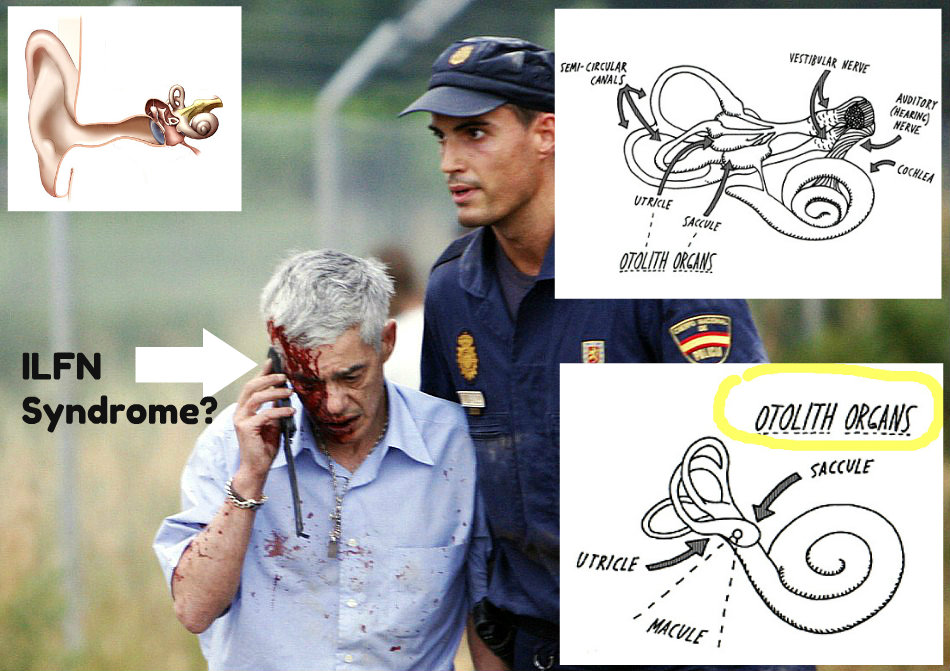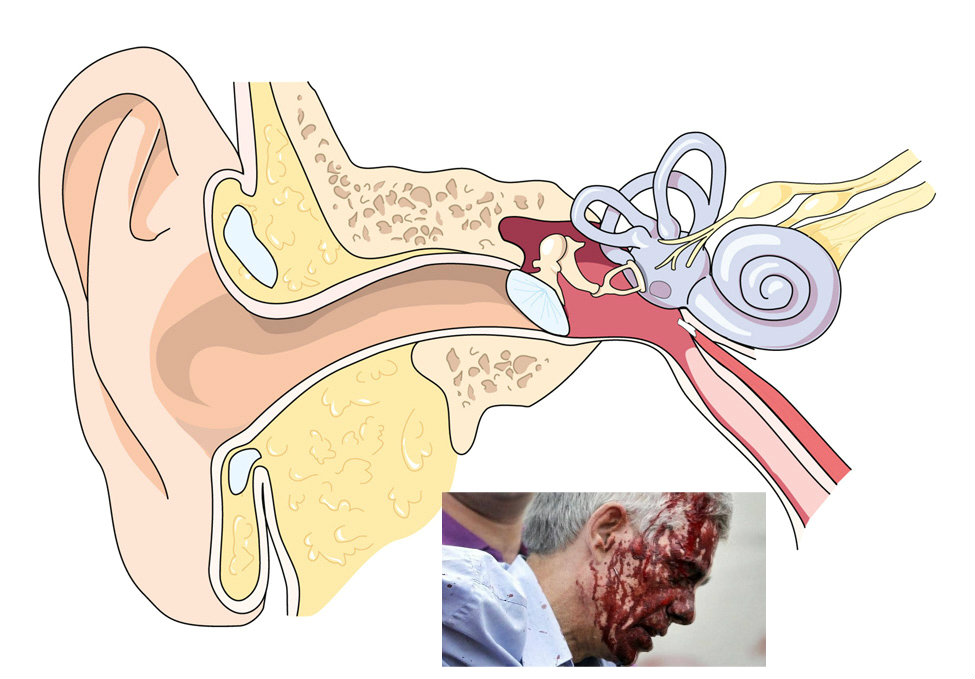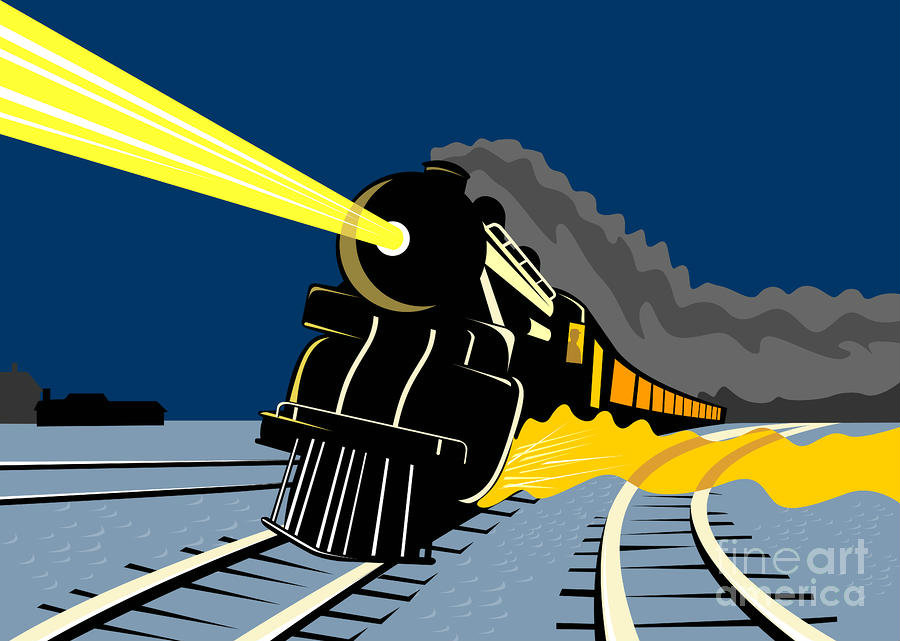Did ILFN Syndrome cause Spain’s worst train wreck? (Nina Pierpont, MD, PhD)
Aug 21, 2013

Editor’s note: Please send this article viral. WTS.com has been unable to reach the engineer’s lawyers, who should be aware that ILFN Syndrome may have had a role in Mr. Garzon’s bizarre behavior.
ILFN, incidentally, is shorthand for Infrasound & Low Frequency Noise. While we are clarifying things: Ignore the fact that Mr. Garzon is talking on a cellphone in the photograph, below. As you will see from reading Pierpont’s article, the problem is not cellphones, the immediate problem is the ILFN-rich engineer’s cockpit of the train engine.
.

His name is Francisco Jose Garzon Amo. Minutes before this snapshot was taken, he was extracted from the cockpit of a high speed train in Spain. Minutes earlier, he had been at the controls of this train as it hurtled around a bend in the tracks.
As all the world learned in the evening news—Mr. Garzon’s death-defying high speed stunt failed. Spectacularly.
The entire nauseating episode was captured by video camera mounted slightly further down the track. One moment the track is empty. Suddenly, an engine pulling a string of passenger cars comes barreling around the bend—tilts—tips over—the flimsy aluminum cars, loaded with people, smashing helter skelter into the pitiless concrete wall.
“I can’t explain it,” a stunned Garzon is quoted as saying. “I still don’t understand how I didn’t see . . . mentally, or whatever. I just don’t know!”
He was ‘going fine’ until the curve was upon him, he said. When the danger became clear, he thought, ‘Oh my God, the curve, the curve, the curve! I won’t make it.’
The driver activated the brakes ‘seconds before the crash . . . the electric one, the pneumatic one . . . all of them. Listen, when . . . but it was already inevitable.’
Garzon went back to court, voluntarily, to offer more evidence on Wednesday. . . . He said he was talking by phone to the train’s on-board ticket inspector moments before the derailment. . . . Garzon was on the phone at the time of the derailment.
—Associated Press, 2 Aug 2013, in Al Jazeera English
“The curve . . . by the time I saw it, I knew I wouldn’t make it,” Garzon told a state prosecutor.
Prosecutor: ‘Did you activate the braking system when you entered the tunnel?’
Garzon: ‘Everything was activated before the train derailed, but by then I saw that no, no, no—I wouldn’t make it!’
Prosecutor: ‘What were you thinking about before entering the second tunnel?’
Garzon: ‘I don’t know! If only I knew! The disgrace which I’m going to have to bear for the rest of my life is tremendous.’
Prosecutor: ‘We are all working on this, the police and others, to find out what was going through your mind. I’m asking you to try harder to see if we are correct . . .’
Garzon: ‘Sir, I’m telling you sincerely, I don’t know! I’m not so crazy that I wouldn’t apply the brakes!'”
—Video by Associated Press, 2 Aug 2013, in Al Jazeera English
The NY Times (7/30/13) reports that Mr. Garzon had received a telephone call from an official of Renfe, the train company, and was “reading a map or some kind of paper document” at the time of the crash.
Investigators say the driver of a Spanish train that crashed . . . received three warnings to reduce speed in the two minutes before the train hurtled off the tracks. The court statement . . . revealed the driver was talking on the phone to a colleague when he received the first automatic acoustic warning in his cabin of a sharply reduced speed zone ahead. The statement said police forensic tests on the train’s black box data recorders showed the last warning came just 250 metres before a dangerous curve where the accident occurred last week.
—Associated Press in Madrid, 2 August 2013, in The Guardian
“Spanish news agencies, quoting police and court sources, said that he admitted he had acted recklessly. But, according to subsequent versions, he said he was confused as to which bit of the route he was traveling on” (The Guardian, 30 July 2013).
“The Alvia has a hybrid electric-diesel engine,” reports The Observer, 27 July 2013. “Video footage shows Garzon’s train hurtled into the bend where the accident took place at more than twice the permitted speed of 80 km/h. Yet the driver was reported to have been famed among colleagues for his prudence.”

Juxtapose this narrative by Mr. Garzon of his thought processes and behavior in the moments before the crash (note: in the cab of an electric-diesel train, traveling at high speed, which had just passed through one tunnel and was entering another), to the following descriptions of the ways in which cognitive processes can be affected by exposure to infrasound in the cab of diesel locomotives, as explained “Infrasound and Low Frequency Noise in the Locomotive Cab,” by B.J. Willingale, presented at the Tenth International Congress on Acoustics in Sydney, Australia, July 1980 (attached):
» “Many engine-men [engineers] complain that both physical and mental fatigue, which sets in fairly early in a shift on a diesel-electric locomotive . . . is in some way contributed to by the cab environment of the diesel-electric locomotive and particularly in relation to noise exposure” (page 1).
» “Complaints were received from engine-men operating on this line relating to the experiences of headaches, nausea and depression. The complaints came from engine-men who would normally show little interest in raising issues concerning their working conditions to the union” (page 1).
» “For some considerable period of time now, the union has shown an interest in literature dealing with infrasound and low-frequency noise exposure. This interest has been cultivated in the light of the alertness and attention an engine-man must pay to his duties in respect to decision-making in the locomotive. While trains do not operate in this state to [at] the speeds encountered in other countries, prompt response to signals and the situation concerning other hazards and operating conditions in the locomotive cab is nevertheless very important one’s to safety. . . . Accurate and prompt response to operating procedures on these larger and faster trains requires a clear mental state” (page 2).
Known literature at the time with regard to the physiological response to infrasound and low-frequency noise (ILFN) is summarized in Table 1 of this paper (pp. 2-4):
» Item 3 shows the response to frequencies of 1-20 Hz at 115 to 120 dB is a “30-40% increase in reaction time, lethargy, euphoria (running off road to drive into danger without being able to mentally reverse one’s actions).”
» Item 25 shows the response to frequencies of 2-15 Hz at 105 dB is “increased reaction time by 10% in 1⁄2 the subjects of a test group.”
» Item 26 shows the response to frequencies of 10-15 Hz, particularly below 10 Hz, and 95 dB to be “increase in tracking error by 10% in a visual experiment.”
» The other 27 items in the list deal with responses related to balance, dizziness, nausea, chest sensations, modulation of speech, swallowing, visual blurring, and headaches.
Noise measurements in the operating diesel-electric locomotive cab revealed levels of infrasound and low-frequency noise sufficient to cause these effects.
Infrasound/low-frequency noise exposure in industrial settings is typically associated with reduced productivity. There is a substantial scientific literature on this.
Exposure to infrasound/low-frequency noise at much lower decibel levels in community settings from the ventilation systems of large buildings (“sick building syndrome”), large wind turbines, or pumps or compressors is likewise associated with disturbed mental processes, particularly difficulty in multi-tasking and difficulty with visual-spatial problem-solving (Pierpont N, 2009, Wind Turbine Syndrome, K-Selected Press, Santa Fe, NM). These effects tend to be cumulative over longer periods of exposure.
In summary, I hypothesize that significant amounts of infrasound/low-frequency noise were present in the cab of the diesel-electric train driven by Mr. Garzon, and that this infrasound/low-frequency noise slowed his reaction time, impaired his ability to multi-task, and interfered with his ability to solve critical visual-spatial problems—where he was in the route, and the immediacy of the approach to the curve.
Immediately before the crash, Mr. Garzon was multi-tasking—it is said that he was talking on the phone on a matter of train business and looking at paperwork. At the same time, he appears not to have registered the auditory warning signals to slow down, nor to have registered and processed the high- speed visual-spatial problem of the approaching curve.
In addition, he had just passed through one tunnel, in which resonance could magnify any noise or infrasound he was exposed to, and was moving into another tunnel.
I suggest that Mr. Garzon’s inability to describe what his mental processes were in those moments, and the suggestion that he was even confused about where he was in the journey, could be the effects of his exposure to infrasound/low-frequency noise. This could explain why someone typically described as responsible and highly competent could do something so apparently out of character.

.
Editor’s note: Dr. Pierpont sent the above article to the editor of a Spanish newspaper that had done extensive reporting on the accident. The editor responded with some questions. Pierpont answered as follows.
Question #1: What, exactly, is ILFN?
Answer: ILFN is infrasound/low frequency noise. Infrasound is defined as noise at the very lowest end of the spectrum, the deepest or lowest-pitched sounds, for many people too low to be heard. It is defined as sound below 20 Hz (which means the number of waves per second). Low frequency noise is the frequencies or pitches above 20 Hz up to 200 Hz or 500 Hz, the upper limit having a flexible definition.
Question #2: How does ILFN affect train drivers?
Answer: In a variety of situations, including in industry, in the aeronautical industry and military, and in large buildings with poorly designed and reverberating ventilation systems (“sick buildings”), the effects of ILFN exposure include nausea, dizziness, fatigue, general malaise, slowed thinking, poor concentration, and difficulty with reading, multi-tasking, productivity, and solving problems with a visual-spatial component (judging distances, for example, or remembering where you are on a mental map). The paper I attached, above, which was a talk given at a technical conference in 1980, shows that the noise inside the cab of new diesel-electric trains in Australia, at the time, was of the correct frequencies (Hz or pitch) and amplitudes (energy, power, or loudness) to produce these kinds of effects on the drivers of trains (whom I called “engineers” in the last e-mail because that is what train drivers are called in the USA). The noise study presented in this paper was undertaken because of the complaints of mental fatigue by the drivers of these trains when the trains were introduced.
Question #3: Do you think something similar happened to Mr. Garzon?
Answer: Yes, I do think something similar could have happened to him. The high speed of the train would intensify the noise. The tunnel or wall he was traveling through or next to could intensify the noise. The driver’s accounts of his mental confusion, slowed reactions, and his inability during his phone call to notice important signals and to mentally grasp how close the curve was and how fast he was approaching it—these features of slowed and ineffective thinking are all consistent with the effects of ILFN exposure on mental processes.
Question #4: What symptoms would a person affected by ILFN present with?
Answer: In my work on ILFN exposures, I have discovered that some people are more susceptible to these effects than others. In particular, migraine disorder, the tendency to become carsick or seasick, and a history of noise-induced damage to the hearing are all risk factors for having ill effects from ILFN. Age over 50 is also a demonstrated risk factor for developing these symptoms.
Question #5: Is there a cure?
Answer: With regard to a remedy, I suggest first that Mr. Garzon be examined by an oto-neurologist, which is an otolaryngologist who specializes in the nerve connections to the ear and balance systems, to see if he has any of the susceptibility factors.
A noise study of the cab of the type of train involved might be useful, with a focus on measuring the infrasound and low frequency noise, by a specialist in this type of noise (it takes special measuring apparatus and expertise to adequately measure it).
Question #6: Has this problem been detected in other train accidents?
Answer: I don’t know of any accidents in which this factor has been examined.
Question #7: Is it only train engineers who are at risk for this? Could operators of other means of transportation be vulnerable?
Answer: With regard to drivers of other modes of transport, Professor Mariana Alves-Pereira (University of Lisbon) and her colleagues have done extensive research on airline pilots, but I don’t know of any accidents that have been ascribed to the ILFN factor. The group she is a part of has measured the ILFN in airline cockpits. I don’t know if anyone has measured ILFN in the cabs of large trucks.
Question #8: Can the symptoms of ILFN be experienced and resolved in minutes, hours, or days? How long do symptoms last?
Answer: There appear to be several stages and perhaps different physiological explanations for early and later effects of ILFN, if someone has repeated episodes of exposure over a long period of time, as we think the train driver did.
The first level involves detection through the sensory system, probably the balance system of the inner ear. Such effects come on in the time frame of minutes to hours and resolve in a similar time frame after the exposure stops. However, there is sensitization over time, so that after repeated episodes the effects happen faster and are stronger, and may take longer to resolve.
The research group of Dr. Nuno Castelo Branco, who did much of his research while working for the Portuguese Air Force, believes that there is more than an effect on the senses when there is long-term, high-intensity exposure to ILFN. They think that tissues of the brain and other organs, such as the heart and blood vessels, are damaged and thickened by long-term, high-intensity exposure to ILFN. The pathology and long-term effects they present in their papers are similar to the effects of multiple concussions in professional American football players.
The Portuguese group uses electrophysiological tests on the brain and echocardiography to diagnose damage from ILFN.
(Professor Mariana Alves-Pereira is a member of this research group. They are the main elucidators of Vibro-Acoustic Disease, or VAD.)
Question #9: What symptoms could Mr. Garzon have had?
Answer: If you look at my analysis of the problem in the article, above, you will see the symptoms I thought the driver had. (Bear in mind, I based all this on newspaper accounts.) Essentially these are malfunctioning of his attention, alertness, ability to think quickly, ability to register and think about multiple things at once or in rapid succession, and ability to rapidly solve visual-spatial problems (such as knowing where you are at a glance and also knowing what is coming next and what speed you should be going).
Symptoms he might have felt himself would be mental fatigue and confusion, slowness of thinking, and confusion after the fact about not having noticed something or not having done something that should have been second nature (meaning, done easily and automatically without much conscious thought).
Question #10: Are there medical tests for identifying susceptibility to ILFN in, say, prospective train drivers?
Answer: If there are mental, cognitive effects that persist after the end of the episode of exposure to ILFN (which there may be—see #8, above), then neuropsychological testing including tests of divided attention and tests of reaction speed might pick up an abnormality. A normal physician’s history and physical would not pick up abnormalities unless the patient told the physician about the mental struggles. If there is no good explanation for the mental difficulty, then a person might be reluctant to talk about it for fear of being blamed for the problem and losing his job.
Apropos of this, I interviewed an air traffic controller who had noticed problems in his work (as did his co-workers) after an ILFN source started up near his home but not near his work. He told the physician about it in his yearly exam for work. The physician considered the problem to be a result of poor sleep and counseled the man to get more sleep, but did not remove the man from work.
.

Nina Pierpont can be reached at pierpont@twcny.rr.com. She wishes to thank Dr. Sarah Laurie, CEO of the Waubra Foundation, for sending her the article on Australian locomotive engineers and ILFN.


Comment by Tom Whitesell on 08/22/2013 at 12:14 am
This is an extremely interesting article. Thanks for posting this.
Comment by Mauri Johansson, MD, MPH on 08/22/2013 at 4:56 am
Dear Nina,
Good idea to describe this possibility!
Some days ago I sent a letter to the Danish railway workers Union asking whether they have done some measures in locomotive cockpits on ILFN, but I have not got any answer yet. I will ask anew, because it is a serious problem. They, like airplane pilots fall asleep.
All my best,
Mauri
Mauri Johansson, MD, MPH (Environmental Medicine specialist, Denmark)
Comment by Melodie Burkett on 08/22/2013 at 8:49 am
Well, at least they asked you for your insight. This is very powerful information. Hopefully these train wreck investigators will grab on to this plausible explanation and publish it for the public.
You have opened the lid to Pandora’s box!
Comment by sue hobart on 08/25/2013 at 10:42 am
Said it before… Nina Pierpont is the sharpest tool in the shed. To be bringing Infrasound into the general light of day on all levels shows the true science.
ultrasound, uv rays, radiation,….they were all wild theories too until they became undeniable.
God blessses You Dr. Pierpont you will be a hero, hopefully sooner rather than later!